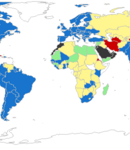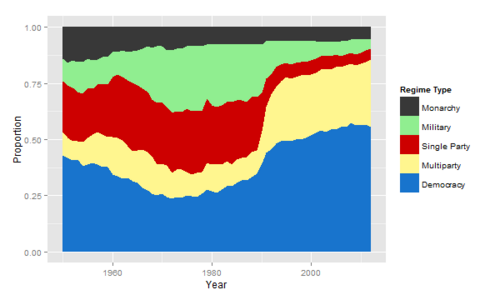

Researchers
Recognizing both historical and contemporary trends in autocratic rule may be fundamental to addressing future research and policy. Instead of treating all governments as democratic or autocratic, recent scholarship in comparative politics and international relations has recognized the importance of opening the “black box” of autocratic rule to better understand varying behavior - such as human rights protection, use of repression, war-proneness, and trade - across these countries.
Policymakers and the general public have also found interest in understanding the dynamics of autocratic governance, especially given recent events in the Middle East. Efforts to study this in a quantitative and large-scale manner necessitate the creation of systematically coded data. Additionally, country experts might benefit from having a resource for making general comparisons. Toward this end, the Autocracies of the World 1950-2012 dataset (abbreviated AoW) is a new initiative led by Stanford researchers to classify the political regime types of all governments between 1950 and 2012 with a special focus on autocracies.
| Image

|
| Proportions of regimes over time. |
The dataset, compiled by Stanford Professor of Political Science Beatriz Magaloni and graduate students Jonathan Chu and Eric Min, uses five classifications, four of which encompass autocracies: democracy, multiparty, single party, military, and monarchy. The dataset categorizes every country-year for countries with populations of 500,000 or greater and ultimately features 8,629 observations. This is the first edition of the AoW and will be extended, updated and corrected in subsequent years.
While several datasets have already classified governments around the world, the AoW offers several innovations that may be of interest to scholars and policymakers alike. Three are highlighted here. First, unlike some extant data, the AoW features no hybrid classifications. Great efforts were made to determine the underlying institutions that control power in a given country-year. Second, the common category of “personalist regime” is removed. Theoretically, the AoW works under the assumption that “personalism” (the degree to which a regime is tied to one specific individual) is a varying feature rather than a category in and of itself. The AoW thus includes two separate measures of personalist rule for all autocracies: one which measures constraints on the executive, and one which measures dependence on a single executive ruler. Third, the AoW corrects numerous inconsistencies found in existing regime classification datasets, as well as filling in many points of missing data. Further details on these additions, as well as a complete technical description of the dataset and its similarities/differences with existing work, are available in the AoW codebook.
| Image

|
| A map of regimes in the year 1965. |
Updated: Oct. 2013
